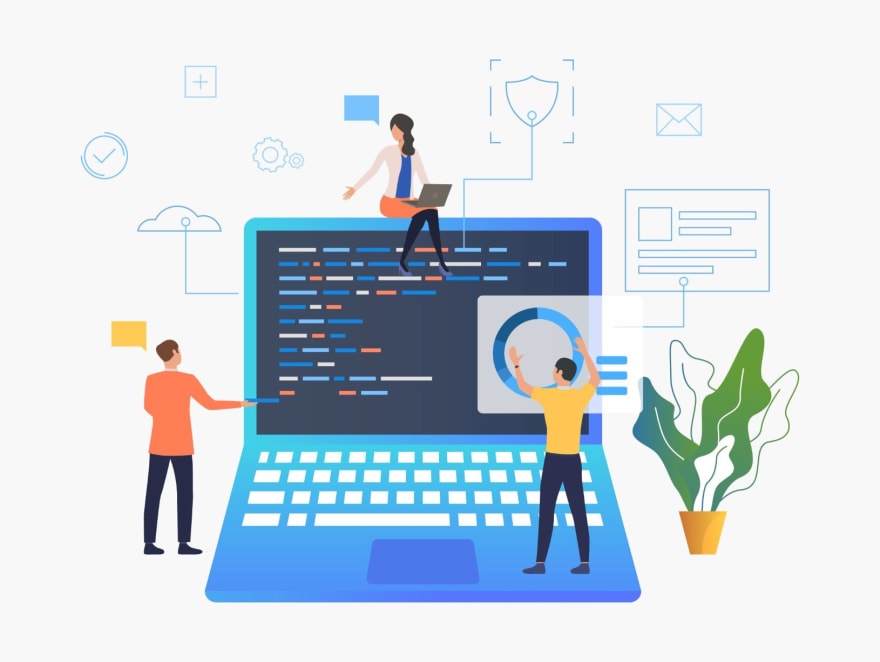
Traditionally, application security measures were limited to the last software development stage of the lifecycle (SDLC). Today, security has become a core feature and consideration at every stage of development.
In this article, we will see how DevSecOps places importance on security as a shared responsibility. We will also discuss how DevSecOps involves thinking about infrastructure and software security from the very beginning and how you can best make the move from DevOps to DevSecOps.
What Is DevOps?
DevOps is an Information Technology (IT) approach that promotes collaboration, communication, automation and integration between IT operations and software developers. The underlying aim of DevOps is to enhance the quality and speed of software delivery, which enables the development of continuous, frequent updates.
DevOps teams work to create consistent development environments and to automate the delivery process, to ensure that the delivery is efficient, predictable, sustainable, and secure. For this purpose, the team can leverage a project management tool for collaboration, machine learning for automation, and any other tool that can help create an efficient pipeline.
The DevOps focus gives developers improved control of production infrastructure and a clearer understanding of the production environment. It also empowers team members by providing them with the freedom to validate, build and deliver their applications.
What Is DevSecOps?
DevSecOps integrates security practices within the DevOps approach. DevSecOps fosters a culture of ‘security as code’ through the partnership between security teams and release engineers. Like DevOps, the DevSecOps approach is geared towards developing innovative solutions for intricate software development processes. This is done within the context of an agile framework.
The goal of DevSecOps is to bridge the gap that traditionally exists between IT and security teams while maintaining the safe and speedy delivery of code. The silo approach is superseded by a way of thinking that ensures shared responsibility of security tasks throughout the delivery process.
In DevSecOps, two apparently adverse goals—secure code and delivery speed—are unified into one efficient process.
Why Should You Make the Move to DevSecOps?
Software vulnerabilities are the cause of most data breaches and as such, security must be a primary concern for all organizations. When an app feature crashes without warning it is bound to annoy users. Furthermore, a security vulnerability that provides an opening for a costly data breach will have a sizable impact on an entire enterprise.
Security has developed considerably in recent years in response to an increase in the sophistication and number of cybersecurity threats. Security measures are now widely being deployed during the development process to assure each variable is accounted for. If a bug is isolated at the end of the delivery pipeline, it is costly to take care of, and teams need to reevaluate and re-run their operations. This can cause delays in delivery. A security bug may even need re-architecting, which will demand even more serious alterations to the functionality.
DevSecOps is an approach that streamlines these procedures by integrating them into the development process. This can help ensure that security vulnerabilities don’t make it to production and that breaches don’t occur. DevSecOps, much like the closely related SecOps, creates more efficient and faster ways to deliver secure code within an agile framework. It augments the collaboration between operation teams and development teams by putting security at the center of the process.
3 Key Elements to Consider When Making the Move
1. Continuous Feedback Loop
Feedback is at the heart of DevSecOps. Establishing a continuous feedback loop will assist developers and help machines gain insight into platform or system vulnerabilities. This form of continuous, real-time feedback can help enterprises create effective rule sets and policies.
The right rules can keep the application security testing tools relevant and up-to-date, in keeping with the state of security of the organization's network, software, and platform. Furthermore, they can keep all team members in the know about possible threats to the DevOps environment.
2. Focused Automation
Focused and continuous automation is key to the success of the DevSecOps process. When organizations incorporate automation into the life cycle of software development, from the onset, they can minimize the tension that can occur between security and development teams over platform and software security.
Automation can do this by promptly attending to existing and possible concerns while incurring minimum costs. There are several open source tools on the market that can help organizations automate their security processes.
3. Shifting to the Left
Organizations must shift left to successfully implement DevSecOps. In this way, they should apply testing and deployments from the onset, and this must continue right up to the end of the process when the platform or software is free of vulnerabilities.
This type of ‘shift left’ philosophy accelerates new developments and helps reduce the number of cybersecurity threats. It also helps security teams attend to existing threats, without excessive monetary investment and with minimal damage to the platform or software.
Other Key Steps for Successful DevSecOps Implementation
To help you move from DevOps to DevSecOps, you should consider establishing a clear adoption plan. To implement this approach throughout your organization, you will have to:
- Maintain tight access security for API endpoints.
- Scan any pre-built container images for known vulnerabilities as they are incorporated in the build pipeline.
- Isolate containers from each another to prevent any dependencies and ensure that they are entirely stateless.
- Automate security updates, like patches for known vulnerabilities, using an audit log.
- Limit the attack surface by employing a secure API gateway that applies scope-grained and fine-grained access to sensitive API endpoints. ## Wrap Up What DevOps was several years ago is where DevSecOps is positioned today. It is a sign of progress that more and more companies are adopting security as an integral part of the development workflow. In the coming months and years, as organizations increasingly adopt DevSecOps, it will be fascinating to see how security tools become more useful for developers and DevOps teams, who will have to respond to automated security measures.






Oldest comments (0)